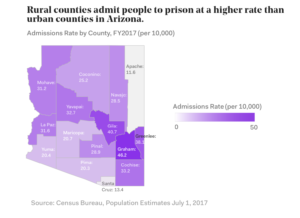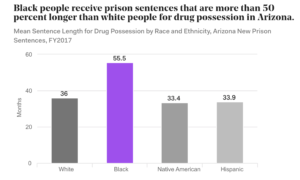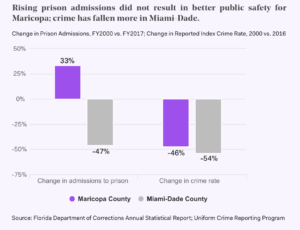WASHINGTON, DC – A new report issued today by FWD.us finds that Arizona’s imprisonment crisis comes at a high cost to communities, and the impact is not felt evenly across the state or demographic groups. The report finds that black and Hispanic people are overrepresented in Arizona’s prisons, and these disparities are largely driven by differences in sentencing for non-violent crimes. It also finds that rural counties send people to prison at higher rates than urban counties.
The report, Arizona’s Imprisonment Crisis: The Cost to Communities, examines the impacts of the broken criminal justice system on communities across the state. After decades of sustained prison growth, Arizona today has the fourth highest imprisonment rate in the country, and the state prison system costs taxpayers more than $1 billion each year without making us safer. This prison growth cannot be explained by more crime or a larger resident population. Instead, it was driven by decisions to send more people to prison for lower-level offenses, and to keep people in prison far longer than the national average.
“Arizona is facing an imprisonment crisis,” said Todd Schulte, President of FWD.us. “But it is not uniform. Some communities in Arizona — including rural communities and communities of color — are bearing the brunt of Arizona’s poor policy choices. For Arizona to move forward and make meaningful reductions in its prison population, these diverse communities need to be consulted and consulted often.”
While urban counties send the greatest number of people to prison, rural counties use prison at a far higher rate. Graham County, for instance, a small rural county, sends 46 people to prison each year for every 10,000 county residents, compared to only 20 people in urban Pima County. This trend holds even when looking solely at non-violent crimes and drug crimes alone.

Additionally, the report finds that Arizona’s imprisonment crisis disproportionately affects communities of color. People of color are overrepresented in the state prison system, in particular for non-violent crimes. For example, Hispanic people comprise about a third of Arizona’s population, but make up almost 60 percent of the individuals sent to prison for marijuana possession, and more than 80 percent of the individuals sent to prison for marijuana distribution. Black people receive the longest average sentences across the board; for drug possession, black people receive prison sentences that are 50 percent longer than white people. These disparities cannot be explained by higher levels of offending — Hispanic people constitute roughly the same share of drug arrests as their share of the population but are sent to prison at far higher rates and research has consistently shown that rates of drug use are similar across demographic groups.

The report also takes a close look at Maricopa County, the largest county in the state and by far the largest contributor to the prison population, demonstrating the county is out of step with other large metropolitan areas. When compared to Miami-Dade County — a similarly sized county with a comparable crime rate, large immigrant population, and sentencing structure —the results are dramatically different. Each year, Maricopa sends six times as many individuals to prison as Miami-Dade. Since 2000, Maricopa has increased admissions to state prison by 33 percent while prison admissions from Miami-Dade have fallen 46 percent. But sending more people to prison has not resulted in better public safety for Maricopa residents –in fact, crime has fallen more in Miami-Dade over this period.

FWD.us is committed to working alongside and building diverse, bipartisan coalitions of Arizonans looking for responsible, data-driven criminal justice solutions. This report covers 30 years worth of data and FWD.us analyzed almost 500,000 records trying to understand why the prison population has grown and what the cost has been to Arizona’s economy, communities, and families. The report released today is the second in a three part series. The first report in this series focused on the impact to Arizona’s economy. Later this fall, FWD.us will release an additional report that examines how Arizona’s criminal justice system hurts women and families.
An executive summary of the report can be found here. A video explainer on the Maricopa/Miami-Dade comparison can be found here.